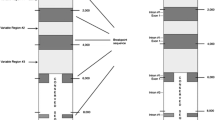Abstract
We have characterized a human genomic clone carrying two pseudogenes for the proliferating cell nuclear antigen (PCNA), which were tandemly arranged on human Chromosome (Chr) 4. One is a processed pseudogene that showed a 73% nucleotide homology to the human PCNA cDNA and possessed none of the introns existing in the functional PCNA gene. This pseudogene presumably arose by reverse transcription of a PCNA mRNA followed by integration of the cDNA into the genome. The other is a 5’ and 3’ truncated pseudogene that showed a nucleotide homology to a 3’ region of the exon 4 and to a 5’ region of the exon 5 of the PCNA gene and did not have the intronic sequence between the exons 4 and 5. Both pseudogenes had the same nucleotide deletion as compared with the human functional PCNA gene. A phylogenetic analysis of PCNA gene family, including the functional PCNA gene and another PCNA pseudogene located on a different chromosome, revealed that the truncated pseudogene exhibits the closest evolutionary relationship with the processed pseudogene, suggesting, that the truncated pseudogene was generated by duplication of the processed pseudogene after translocation to Chr 4. Furthermore, fluorescence in situ hybridization revealed that these pseudogenes are located on the long arm of Chr 4, 4q24.
Similar content being viewed by others
References
Almendral, J.M., Huebsh, D., Blundell, P.A., Macdonald-Bravo, H., Bravo, R. (1987). Cloning and sequence of the human nuclear protein cyclin: homology with DNA-binding proteins. Proc. Natl. Acad. Sci. USA 84, 1575–1579.
Arimori, K., Koido, S., Yoshimura, S., Taniguchi, Y., Arimori, S., Moriuchi, T. (1994). Nucleotide sequence of a human genomic DNA fragment containing the PCNA pseudogene and its localization on chromosome 4. Tokai Exp. Clin. Med. 19, 1–5.
Ina, Y. (1992). ODEN: Molecular Evolutionary Analysis System for DNA and Amino Acid Sequences, ver. 1.1.1. DNA Data Bank of Japan, Mishima.
Inoko, H., Ando, A., Kimura, M., Tsuji, K. (1985). Isolation and characterization of the cDNA clone and genomic clones of a new HLA class II antigen heavy chain, DO alpha. J. Immunol. 135, 2156–2159.
Jaskulski, D., DeReil, J.K., Mercer, W.E., Calabretta, B., Baserga, R. (1988). Inhibition of cellular proliferation by antisense oligodeoxynucleotides of PCNA cyclin. Science 240, 1544–1546.
Kimura, M. (1980). A simple method for estimating evolutionary rates of base substitutions through comparative studies of nucleotide sequences. J. Mol. Evol. 16, 111–120.
Ku, D., Travali, S., Calabretta, B., Heubner, K., Baserga, R. (1989). Human gene for proliferating cell nuclear antigen has pseudogenes and localizes to chromosome 20. Somatic Cell Mol. Genet. 15, 297–307.
Leibovici, M., Gusse, M., Bravo, R., Mechali, M. (1990). Characterization and developmental expression of Xenopus proliferating cell nuclear antigen (PCNA). Dev. Biol. 141, 183–192.
Lichter, P., Cremer, T., Borden, J., Manuelidis, L., Ward, D.C. (1988). Delineation of individual human chromosomes in metaphase and interphase cells by in situ suppression hybridization using recombinant DNA libraries. Hum. Genet. 80, 224–234.
Matsumoto, K., Moriuchi, T., Koji, T., Nakane, P.K. (1987). Molecular cloning of cDNA coding for rat proliferating cell nuclear antigen (PCNA)/cyclin. EMBO J. 6, 637–642.
Moriuchi, T. (1990). Proliferating cell nuclear antigen (PCNA): a nuclear protein engaged in eukaryotic DNA replication for one billion years. Med. Sci. Res. 18, 911–915.
Novacek, M.J. (1992). Mammalian phylogeny: shaking the tree. Nature 356, 121–125.
Pearson, W.R., Lipman, DJ. (1988). Improved tools for biological sequence analysis. Proc. Natl. Acad. Sci. USA 85, 2444–2448.
Prelich, G., Stillman, B. (1988). Coordinated leading and lagging strand synthesis during SV40 DNA replication in vitro requires PCNA. Cell 53, 117–126.
Prelich, G., Kostura, M., Marshak, D.R., Mathews, M.R., Stillman, B. (1987). The cell-cycle regulated proliferating cell nuclear antigen is required for SV40 DNA replication in vitro. Nature 326, 471–475.
Saitou, N., Nei, M. (1987). The neighbor-joining method: a new method for reconstructing phylogenetic trees. Mol. Biol. Evol. 20, 1–10.
Sanger, F., Nicklen, S., Coulson, A.R. (1977). DNA sequencing with chain-terminating inhibitors. Proc. Natl. Acad. Sci. USA 74, 5463–5467.
Takahashi, E., Hori, T., O’Connell, P., Leppert, M., White, R. (1990). R-banding and nonisotopic in situ hybridization: precise localization of the human type II collagen gene (COL2A1). Hum. Genet. 86, 14–16.
Takahashi, E., Yamauchi, M., Tsuji, H., Hitomi, A., Meuth, M., Hori, T. (1991). Chromosome mapping of the human cytidine-5’-triphosphate synthetase (CTPS) gene to band 1p34.1-p34.3 by fluorescence in situ hybridization. Hum. Genet. 88, 119–121.
Thompson, J.D., Higgins, D.G., Gibson, T.J. (1994). CLUSTAL W: improving the sensitivity of progressive multiple sequence alignment through sequence weighting, position-specific gap penalties and weight matrix choice. Nucleic Acids Res. 22, 4673–4680.
Travali, S., Ku, D., Rizzo, M.G., Ottavio, L., Baserga, R., Calabretta, B. (1989). Structure of the human gene for the proliferating cell nuclear antigen. J. Biol. Chem. 264, 7466–7472.
Wilde, C.D. (1986). Pseudogenes. Crit. Rev. Biochem. 19, 323–352.
Yamaguchi, M., Hayashi, Y., Hirose, F., Matsuoka, S., Moriuchi, T., Shiroishi, T., Moriwaki, K., Matsukage, A. (1991). Molecular cloning and structural analysis of mouse gene and pseudogenes for proliferating cell nuclear antigen. Nucleic Acids Res. 19, 2403–2410.
Author information
Authors and Affiliations
Additional information
Sequence data from this article have been deposited with the DDBJ/ EMBL/Gen Bank Data Libraries under Accession No. D17326 and D17327.
Rights and permissions
About this article
Cite this article
Taniguchi, Y., Katsumata, Y., Koido, S. et al. cloning, sequencing, and chromosomal localization of two tandemly arranged human pseudogenes for the proliferating cell nuclear antigen (PCNA). Mammalian Genome 7, 906–908 (1996). https://doi.org/10.1007/s003359900266
Received:
Accepted:
Issue Date:
DOI: https://doi.org/10.1007/s003359900266




